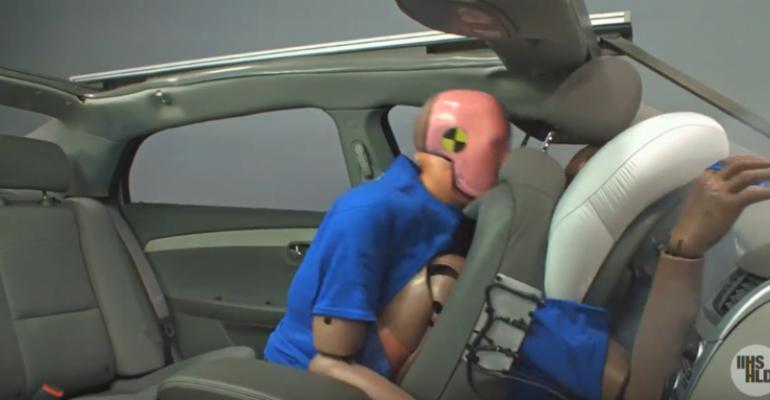Most Americans buckle up, but there’s a gap between the front and back seats – both literally and in terms of seatbelt use.
Among adults who admit to not always using seatbelts in the back seat, four out of five surveyed by the Insurance Institute for Highway Safety say they don’t fasten the belt on short trips or when traveling by taxi or a ride-hailing service.
The IIHS surveyed adults 18 and older by phone between June and August 2016. Of the 1,172 respondents who said they had ridden in the back seat of a vehicle during the preceding six months, 72% said they always used their belt in the back seat, while 91% said they always buckled up when seated in front. This parallels the 2015 nationwide observed belt use of 75% for adult rear-seat occupants and 89% for drivers and front-seat passengers.
The new survey indicates many rear-seat passengers don’t think seatbelts are necessary because they perceive the back seat to be safer than the front. This was true in vehicles from the 1960s and 1970s, but advances in safety technology and crashworthiness since then have narrowed the rear-seat passenger’s safety advantage, the IIHS says in a news release.
“For most adults, it’s as safe to ride in the back seat as the front seat, but not if you aren’t buckled up,” says Jessica Jermakian, an IIHS senior research engineer. “That applies to riding in an Uber, Lyft or other hired vehicle, too.”
More than half of the people killed in car crashes in the U.S. each year are unbelted, IIHS says. “People who don’t use safety belts might think their neglect won’t hurt anyone else. That’s not the case,” Jermakian says. “In the rear seat a lap/shoulder belt is the primary means of protection in a frontal crash. Without it, bodies can hit hard surfaces or other people at full speed, leading to serious injuries.”
The survey found 66% of adults aged 35 to 54 were the least likely group to report always buckling up in the back seat. That compared with 76% of adults 55 and older and 73% of adults 18 to 34. Women were more likely than men to report always buckling up in the rear seat, and adults who had attended college were more likely to use a rear seatbelt than adults with less education.
A quarter of respondents in the group who reported buckling up less often in the back seat than in the front said they believe the rear seat is safer than the front, so using a belt isn’t necessary. The next most-popular reason was that using a belt isn’t a habit or they forget about it or simply never or rarely use it. Twelve percent of respondents cited uncomfortable or poorly fitting belts, and 10% said the belt is difficult to use or they can’t find the belt or buckle.
People who reported most of their trips as a rear-seat passenger were in hired vehicles were more likely to report not always using their seatbelt than passengers in personal vehicles. In the survey, 57% of passengers in hired vehicles reported always buckling up in the rear seat, compared with 74% of passengers in personal vehicles.
“If your cab or ride-hailing driver is involved in a crash, you want that safety belt,” Jermakian says. “Even if state law says belts are optional, go ahead and buckle up anyway. If you can’t find the belt or it’s inaccessible, ask your driver for help.”
IIHS studies have shown driver belt use is higher and fatality rates are lower in vehicles with enhanced belt reminders than in vehicles without them. Nearly two-thirds of part-time belt users and nonusers said audible rear-seatbelt reminders would make them more likely to buckle up. But in 2015, only 3% of models sold in the U.S. had rear-seatbelt reminders, and the number hasn’t increased appreciably in newer vehicles, the industry group says.
Nearly 40% of people surveyed said they sometimes don’t buckle up in the rear seat because no law requires it. If there were such a law, 60% of respondents said it would persuade them to use belts in the back seat. A greater percentage said they more likely would buckle up if the driver could get pulled over because a rear-seat passenger wasn’t buckled.
Except for New Hampshire, all states and the District of Columbia require adults in the front seat to use belts. All rear-seat passengers are covered by laws in 29 states and D.C.
Aside from stronger belt laws, more than half of part-time belt users and nonusers said more comfortable belts would make them more likely to buckle up in the rear seat. They want softer or padded belts, plus shoulder belts that are adjustable so they don’t rub the neck. Respondents cited a variety of comfort and usability issues, regardless of age or body size.
Safety belts saved 13,941 lives during 2015, NHTSA estimates. If everyone buckled up, an additional 2,800 deaths could have been prevented. For drivers and front passengers, using a lap and shoulder belt reduces the risk of fatal injury 60% in a pickup, SUV or van and 45% in a car.





